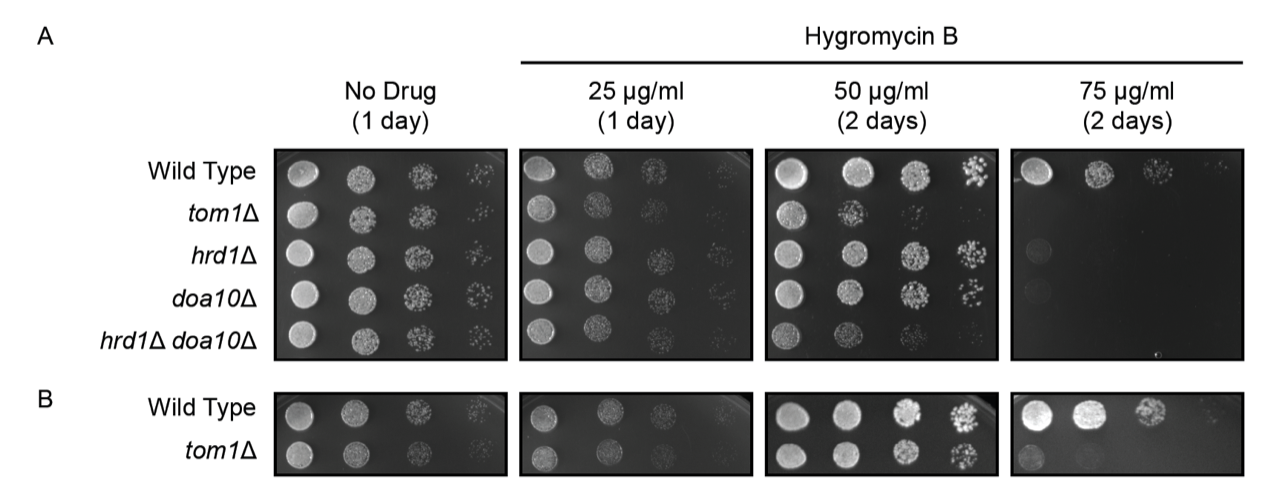Description
The ubiquitin ligase Tom1p contributes to regulated protein degradation, protein quantity control, and protein quality control in Saccharomyces cerevisiae. While GFP-tagged Tom1p is found in both the cytosol and nucleus, the majority of the protein is nuclear (Defenouillere et al. 2017). Among other substrates, Tom1p promotes the turnover of the DNA replication factor Cdc6p (Kim et al. 2012) and the ubiquitin ligase Dia2p (Kim and Koepp 2012) in a cell cycle-dependent manner. The enzyme also mediates the destruction of supra-stoichiometric histone molecules (Singh et al. 2009) and ribosomal proteins (Sung et al. 2016). Further, Tom1p promotes the solubility of multiple aggregation-prone proteins (Theodoraki et al. 2012; Defenouillere et al. 2017). Knockout or knockdown of the mammalian homolog Huwe1 stabilizes excess ribosomal proteins (Sung et al. 2016), suggesting conservation of enzyme function.
Given its described role in protein quality control, we predicted that cells lacking Tom1p would exhibit enhanced sensitivity to conditions associated with increased abundance of aberrant proteins. The aminoglycoside hygromycin B causes ribosome A site distortion and reduces translational fidelity, leading to the production of inaccurately synthesized polypeptides (Brodersen et al. 2000; Ganoza and Kiel 2001). Loss of several quality control enzymes sensitizes cells to sublethal doses of hygromycin B (e.g. (Bengtson and Joazeiro 2010; Verma et al. 2013; Crowder et al. 2015)). Tom1p functions with the ubiquitin-conjugating enzymes Ubc4p and Ubc5p (Singh et al. 2009). ubc4Δ yeast are hypersensitive to hygromycin B; UBC5 knockout enhances this sensitivity (Chuang and Madura 2005). In this study, we analyzed the fitness of cells lacking TOM1 in the presence of hygromycin B.
Wild type yeast, tom1Δ yeast, and three other yeast strains with mutations in protein quality control ubiquitin ligases (Nillegoda et al. 2010; Mehrtash and Hochstrasser 2018) were subjected to six-fold serial dilution, beginning with an optical density at 600 nm of 0.2. 4 μl of each dilution was spotted onto agar plates containing non-selective yeast growth medium with no drug or varying concentrations of hygromycin B (Figure 1A). Plates were incubated at 30°C. All yeast strains displayed similar growth in the absence of drug. As previously reported, yeast lacking either endoplasmic reticulum-associated degradation (ERAD) ubiquitin ligase HRD1 or DOA10 exhibited modest sensitivity to hygromycin B, while hrd1Δ doa10Δ double mutants were highly sensitive to the drug (Crowder et al. 2015). Finally, deletion of TOM1 caused a growth defect on hygromycin B comparable to loss of both ERAD enzymes. Similar results were obtained with an independently generated tom1Δ yeast strain (Defenouillere et al. 2017), providing additional support for this phenotype (Figure 1B).
Hygromycin B reduces ribosomal accuracy, which is expected to increase the abundance of aberrant proteins (Brodersen et al. 2000; Ganoza and Kiel 2001). A subset of these aberrant proteins is likely to be targeted by cellular protein quality control mechanisms. Indeed, loss of several quality control factors (including Ubc4p and Ubc5p) sensitizes yeast to hygromycin B (Chuang and Madura 2005; Bengtson and Joazeiro 2010; Verma et al. 2013; Crowder et al. 2015). Our results indicate that Tom1p is also critical for maximal growth in the presence of hygromycin B. This is consistent with a substantial role for Tom1p in protein quality control. Ubc4p and Ubc5p function with multiple ubiquitin ligases, including Tom1p (Singh et al. 2009; Xie et al. 2010; Stoll et al. 2011). Future experiments will determine the extent to which loss of Tom1p function accounts for hygromycin B sensitivity observed in cells lacking Ubc4p and Ubc5p.
This experiment was piloted by undergraduate students in the Fall 2019 Methods in Cell Biology (BIO 315) Course at Ball State University and has been validated by two (Figure 1B) or three (Figure 1A) replications in the research laboratory of EMR.
Reagents
Yeast strains used in this study
| Name | Alias | Genotype | Figure | Reference |
| VJY476 | BY4741 | MATa his3Δ1 leu2Δ0 ura3Δ0 met15Δ0 | 1A | (Brachmann et al.1998) |
| VJY22 | MATa his3Δ1 leu2Δ0 ura3Δ0 met15Δ0 hrd1Δ::kanMX4 | 1A | (Tong et al. 2001) | |
| VJY102 | MATa his3Δ1 leu2Δ0 ura3Δ0 met15Δ0 doa10Δ::kanMX4 | 1A | (Tong et al. 2001) | |
| VJY305 | SKY252 | MATa his3Δ1 leu2Δ0 ura3Δ0 met15Δ0 hrd1Δ::kanMX4 doa10Δ::kanMX4 | 1A | (Habeck et al.2015) |
| VJY656 | MATa his3Δ1 leu2Δ0 ura3Δ0 met15Δ0 tom1Δ::kanMX4 | 1A | (Tong et al. 2001) | |
| VJY477 | BY4742 | MATα his3Δ1 leu2Δ0 lys2Δ0 ura3Δ0 | 1B | (Brachmann et al.1998) |
| VJY788 | LMA2948 | MATα his3Δ1 leu2Δ0 lys2Δ0 ura3Δ0 tom1Δ::LEU2 | 1B | (Defenouillere et al. 2017) |
Yeast were cultured in yeast extract-peptone-dextrose medium (Guthrie and Fink 2004) with the indicated concentrations of hygromycin B (Corning).
Acknowledgments
We thank Micheline Fromont-Racine for generously sharing a yeast strain. We thank Geoff Mearns, Susana Rivera-Mills, Susan McDowell, Maureen McCarthy, and Kemuel Badger for supporting the involvement of undergraduates in authentic, immersive research experiences at Ball State University.
References
Funding
This work was funded by NIH grant R15 GM111713 (EMR). This project was conceived while EMR was supported in part by a Ball State University Excellence in Teaching award (sponsored by the Ball State University Division of Online and Strategic Learning and the Office of the Provost).
Reviewed By
AnonymousHistory
Received: November 8, 2019Accepted: December 2, 2019
Published: December 6, 2019
Copyright
© 2019 by the authors. This is an open-access article distributed under the terms of the Creative Commons Attribution 4.0 International (CC BY 4.0) License, which permits unrestricted use, distribution, and reproduction in any medium, provided the original author and source are credited.Citation
Niekamp, JM; Evans, MD; Scott, AR; Smaldino, PJ; Rubenstein, EM (2019). TOM1 confers resistance to the aminoglycoside hygromycin B in Saccharomyces cerevisiae. microPublication Biology. 10.17912/micropub.biology.000193.Download: RIS BibTeX




